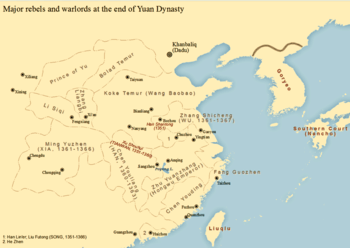Ming Yuzhen
Ming Yuzhen (Chinese: 明玉珍; 1331 – summer 1366) was a peasant who established the rebel Empire of Xia (大夏 "Great Xia") during the late Yuan dynasty in China.
| Ming Yuzhen | |||||||||
|---|---|---|---|---|---|---|---|---|---|
| Emperor | |||||||||
| Reign | 1362 - 1366 | ||||||||
| Predecessor | (none) | ||||||||
| Successor | Ming Sheng | ||||||||
| Born | 1331 | ||||||||
| Died | 1366 | ||||||||
| |||||||||
| House | Ming Xia | ||||||||
| House | House | ||||||||

Ming was born in Suizhou (today Sui County, Hubei) in a farmer family. He changed the character of his surname to mean "Brilliance" later. In 1353 he joined the Red Turbans, a rebel group led by Xu Shouhui. He was blinded in the right eye during a battle.
In 1360, Xu was killed by Chen Youliang, so Ming left his group and proclaimed himself King of Longshu (隴蜀王). Two years later, he proclaimed himself Emperor of Great Xia in Chongqing, with the era name of Tiantong (天統). In Great Xia, there was taxation, imperial examination, and a state religion of Buddhism.
In 1363, he attacked Prince Liang, Bolud Temür (孛羅帖木兒) in Yunnan. His plans to expand did not work out and he died in of illness at the age of 35. He was succeeded by his son Ming Sheng (明昇), who changed the era name to Kaixi (開熙) and was exiled to Korea when Longshu was destroyed by the Ming Empire in 1371. The Korean official Yun Hui-chong's daughter married Ming Sheng in March 1373. Ming Sheng was 17 and Chen Li was 21 when they were sent to Korea in 1372 by the Ming dynasty.[1][2][3][4][5]
Also, Ming Yuzhen is the founder of one of the Korean clan, Yeonan Myeong clan, Seochok Myeong clan and Namwon Seung clan.[6][7]
References
- Goodrich, Luther Carringto (1976). Dictionary of Ming Biography, 1368-1644, Volume 2 (illustrated ed.). Columbia University Press. p. 1072. ISBN 023103833X.
- Flow Cytometry and Cell Sorting (illustrated ed.). Springer Science & Business Media. 2000. p. 1072. ISBN 3540656308.
- Farmer, Edward L., ed. (1995). Zhu Yuanzhang and Early Ming Legislation: The Reordering of Chinese Society Following the Era of Mongol Rule. BRILL. p. 22. ISBN 9004103910.
- Serruys, Henry (1959). The Mongols in China During the Hung-wu Period (1368-1398). Impr. Sainte-Catherine. p. 31.
- Serruys, Henry (1967). Sino-Mongol Relations During the Ming, Volume 1. Institut belge des hautes études chinoises. p. 31.
- Academy of Korean Studies 서촉명씨 西蜀明氏. Academy of Korean Studies.
- JIN Guanglin (2014). A Comparison of the Korean and Japanese Approaches to Foreign Family Names (PDF). Journal of Cultural Interaction in East Asia Vol.5 Society for Cultural Interaction in East Asia.CS1 maint: multiple names: authors list (link)p20